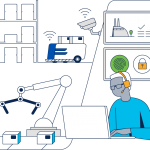At the 2017 Hannover Messe this week, I talked with dozens of manufacturing execs trying to figure out how to move forward their platforms, teams, and philosophies to enable Industrie 4.0 outcomes at scale.
Our customers are already connecting thousands of intelligent devices and demanding new transparency from their vendors: They want to liberate plant floor data from operational silos and proprietary technologies. Only by doing this will they be able to adapt to the latest advances in automation, sensor technology, and machine learning… not to mention the economic imperative to get in front of tightening competition due to globalization.

To take full advantage of new technologies now hitting manufacturing – like predictive analytics, cloud computing, mobility, and collaboration – it’s critical to align operation technology goals with company IT teams. It is time to unite the Operational and the IT tribes so we can succeed together in enabling Industrie 4.0, beyond paper projects.
As I learned at Hannover, there are 5 major issues that manufacturing execs are thinking about as they work to integrate their various industrial systems with each other and with IT’s.
Here they are:
We Need Open Data Platforms
Contemporary machine learning technology means that we are getting new capabilities to see patterns and signals in data that we used to discard as noise, that we can use to improve operational efficiency.

Currently, many shop floors run legacy protocols designed for command and control; they were not designed to feed bits into a data warehouse. Without a way to collect, collate, and store data from different systems, the opportunity to harvest this data is lost.
(This is why we build switches like the IE 4000 line that support multiple protocols and standards which is the first step is bringing the data streams together. CAM for IOT Intelligence helps to connect and organize all the new streams of IOT diagnostic data for business improvement whether from sensors, machines, IP cameras, or asset and people location tags.)
We Must Move Beyond Computing Silos
The massive increase in the data flows we will be processing means that we also need to look at where and how we are doing that processing. The old client/server model, with designated machines working on particular projects, isn’t manageable and does not scale. We’ve got to get our data and our processing out of silos. We need processing at the “edge,” the interface between shop floor machines and the data centers that are archiving their information.
I’ve seen how rigid compute platforms don’t work, and I’ve also seen how they do. One of our partners, for example, provides software libraries for our IoT edge Gateways. The software speaks many industrial protocols and interfaces to dozens of PLCs and automation devices. It makes it possible for switching hardware to be used as data protocol translators, helping liberate data from those silos.
Device Management is About to Get Unmanageable
With all these new devices and sensors coming online and getting put on a common network, we need a way to keep them all monitored and updated. Most current management structures aren’t going to be able to handle this.

We’re going to need new products to manage this network infrastructure. Our Industrial Network Director and our Fog Director are two unique solutions. They will make it possible to manage the devices and to perform statistical analysis at the edge of the network to slim down the data sets sent on for further business analysis and archiving.
Security is Keeping People Awake at Night
There is a massive risk to putting industrial equipment on a network shared with IT and connected to the global Internet: IT will also be free to share all its malware and hacker attacks. Unfortunately, the practice of keeping the industrial network safe by simply keeping it isolated is coming to an end.
IT personnel are accustomed to large attack surfaces. It’s a constant game of cat and mouse in which, for the most part, the good guys manage to keep slightly ahead. But the tools that IT uses to protect data networks don’t always apply to industrial systems. You can’t just take one machine offline at a random time to patch its operating system, for example – no matter how critical the security issue.
I listened to several concerned industrial experts and customers at Hannover who wanted to learn from Cisco’s IT leaders about factory floor security and how to better protect connected operational environments. We’ve been learning from industrial leaders for years and our current products bring together the best security practices from both sides.
Conclusion: Aligning Industry with Information Technology
Industrial technology projects are driven by business, not back-office needs. Everything we do with data on the shop floor is aimed at directly improving product quality, boosting manufacturing speed, lowering direct cost, or some other process that directly goes to the bottom line. Operational necessity is the driver of our digital transformation.
While industry has been hardening its machine-to-machine networking to exist in physically punishing environments, IT has built systems that can process massive amounts of information and (for the most part) stay secure and globally connected at the same time. Merging the disciplines is difficult, but both groups have a lot to learn from each other and the new combined industrial/IT networks will be much stronger for it, and more powerful for businesses, too.
View our Digital Manufacturing website and watch out Hannover Messe highlights video to learn more:

CONNECT WITH US